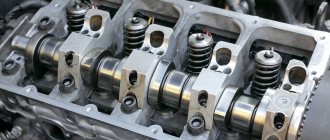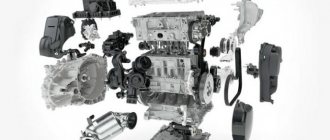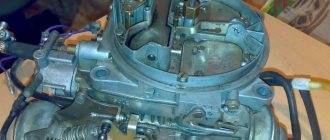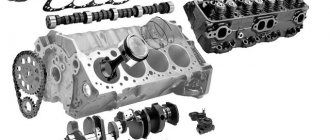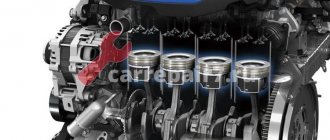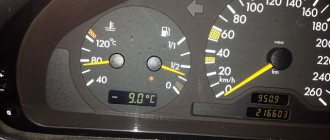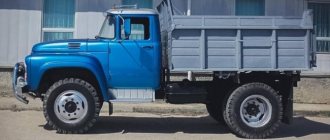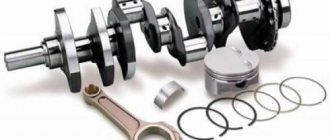Reasons for piston failure
Most modern internal combustion engines are designed in such a way that repairing the pistons is not possible. Therefore, if they break down, there are two options: purchasing a new cylinder block with a crank mechanism (crank mechanism) or completely replacing the power unit.
In order for the engine to work as long as possible, it should be diagnosed and replaced with consumables in a timely manner. In addition, it is important to know and take into account all the factors that contribute to shortening the service life of the pistons.
Pistons operate under high temperatures, and this is most often the main reason for their failure. When overheating occurs, the gap between the piston and the cylinder walls decreases, which increases friction. The pistons themselves heat up and increase in size. As a result, burrs appear on skirts and surfaces interacting with them.
The nature and position of scuffs allows us to determine the causes of their occurrence. For example, if they appear over the entire surface of the piston skirt, this indicates general overheating of the engine.
The reasons for engine overheating may be:
- Poor circulation of coolant or engine oil
- Thermostat not working
- Radiator clogged
- Reduced antifreeze level due to leakage
- Pump damage
- Cooling fan malfunction, etc.
If there is insufficient lubrication, the piston pin turns blue and gaps appear in the boss area. Depending on the design of the engine, the pins can be floating (independent) or fixedly mounted in the upper part of the connecting rod. When the first type of pins jams in the connecting rod bushing, the bosses overheat, which causes scuffs to form on the skirt in the area where they are located.
When the piston head overheats, scuff marks form between the bottom of the piston and the upper groove of the compression ring. In gasoline engines, this occurs due to detonation or spark ignition, when the fuel mixture ignites prematurely.
The causes of scuffing, in addition to engine overheating, can be:
- Knock sensor malfunction
- Using low octane fuel
- Failure to adjust fuel injectors in diesel engines
- Mismatch of the glow number of spark plugs with engine parameters
- Incorrectly set ignition timing
- Fuel mixture too rich/lean
Due to overheating, cracks may form in certain areas of the lower part of the pistons, and the metal from which the parts are made may also melt.
If detonation or glow ignition inside the engine cylinders is not detected in a timely manner, it is worth preparing to repair the cylinder-piston group. Due to such problems, the piston rings and their seats are destroyed, the edges of the bottom are melted, and other damage occurs, which completely disables the pistons.
In diesel engines, damage to the piston rings and their seats indicates severe combustion of the fuel mixture. The same can happen due to the use of low-quality fuel, a large number of different additives, incorrect operation of the injectors, or interruptions in the operation of the ignition system.
Increased wear of the pistons can occur due to the washing away of the protective oil film from their walls. This often happens due to incorrect ignition operation, contamination of the particulate filter, constant cold engine starts and disruption of the ignition process of the fuel mixture inside the cylinders.
If there is no mechanical wear of the cylinder-piston group, you can determine whether the working elements need replacement by the condition of the piston rings and their seats. In practice, the most common reason for urgent repair of the CPG is a broken timing belt or chain.
There are other reasons that indicate an urgent need to repair the piston part of the engine.
When the piston rings are damaged, carbon deposits begin to form on these elements, pistons and cylinder walls. Compression decreases or disappears completely, exhaust gases begin to enter the crankcase, oil consumption increases, and the likelihood of its coking increases.
A significant decrease in the mobility of the rings entails problems with starting the engine and the appearance of smoke in the exhaust gases.
Structural and functional features of pistons in internal combustion engines
A particular difficulty in the restoration process is the failure of a piston in a power unit, the design of which does not allow repair of the piston part. Unfortunately, most modern internal combustion engines have a type of design that completely eliminates access to the pistons.
Therefore, in the event of a breakdown, it is not difficult to foresee two scenarios:
Such prospects are not particularly encouraging for car owners. For this reason, it is extremely important to pay due attention to the condition of the piston part, carry out preventive measures and replace consumables in a timely manner. It is necessary to know and take into account all the factors that shorten the service life of the pistons.
In terms of functionality, the piston is a movable element of the combustion chamber, which, under the influence of pressure caused by the combustion of the fuel mixture, moves freely between the bottom and top dead centers. Thus, the crankshaft and connecting rod of the power unit are set in motion. The process of fuel combustion inside the engine cylinders is due to the abundant release of thermal energy, which, due to the design features of the unit, is converted into mechanical energy. All internal combustion engines operate on this principle.
In addition to constant high pressure, the piston is exposed to increased temperature. It is known that during overheating the piston increases significantly in size due to the expansion of the material from which it is made. To prevent the piston from jamming inside the cylinder, this element has a special barrel-shaped design, the lower part of which is maximally enlarged in diameter. To put it simply, the design feature of the piston is fully taken into account: its skirt does not heat up as much as the head, which is located at the top point where the piston rings are located. Also, for additional cooling of the element, its bottom may have a special coating of heat-insulating material.
In addition, most power unit designs provide for cooling of the piston part due to the circulation of engine oil.
Piston repair
Summarizing the above, we can highlight the following defects that can occur on pistons during operation:
- Wear of holes in bosses
- Wear of piston ring grooves
- Wear by diameter
- Cracks and burrs on the walls
- Carbon deposits on the bottom and in the grooves under the rings
Carbon deposits are removed from the bottom using a blunt metal scraper or brush. The pre-contaminated area is treated with kerosene.
A special device is used to remove carbon deposits from the grooves.
The presence of cracks in the piston can be determined by ear. To do this, the part is taken by the head, and light blows are applied to the skirt with a metal object. A dull and rattling sound is a sign of the presence of cracks.
Pistons with cracks, deep scratches and large diameter wear cannot be repaired. Worn grooves can be turned on a lathe using a ring with an outer diameter that is equal to the inner centering belt of the piston. This will allow you to install rings with an increased height. The grooves are machined taking into account the repair dimensions of the piston rings.
Wear of the holes in the bosses is eliminated by reaming them to an increased diameter. This is done using a sliding screwdriver with a guide shank. Short reamers should not be used, as they easily disrupt the perpendicularity of the pin axis with the piston axis. That is why, after the deployment operation, it is necessary to check the perpendicularity on a special device.
This is done as follows. The piston is placed on the finger of the device and moved close to the stand. The indicator pin, which is mounted on the stand, must be in contact with the piston. The indicator arrow will show a certain deviation. Having recorded its readings, the piston is removed and put on the finger with the other side. The difference in measurements should not exceed 0.05 mm. If it is larger, the piston is rejected.
Restoring the anti-friction coating on the piston skirts
Manufacturers cover the piston skirts of modern engines with special anti-friction coatings. They reduce the coefficient of friction, promote additional cooling of surfaces and reduce wear of parts. However, over time, the factory coating deteriorates and needs to be restored.
To create a new protective layer on the pistons or restore a damaged one, MODENGY anti-friction solid lubricant coating is used for internal combustion engine parts. Let's consider how the procedure for applying this material occurs.
First of all, the surface of the piston skirt is thoroughly cleaned of firmly adhered contaminants: carbon deposits, oxide films, remnants of the old coating using an accessible mechanical or chemical method. Then those areas of the part where the coating is undesirable are covered.
Next, the pistons are treated with a special cleaner-activator MODENGY. It completely evaporates in 10-15 minutes, after which the coating itself is applied.
The aerosol can is first shaken for at least 3 minutes after the sound of the balls appears.
The first layer of material is applied to the surface from a distance of 20-30 centimeters. The procedure should be performed with quick, repetitive movements. After 10 minutes, when the coating acquires a matte tint, you can apply a second layer if necessary. The total coating thickness should be 10-20 microns.
In case of inaccurate application and smudges, the uncured composition can be removed from surfaces using MODENGY activator cleaner.
Once coated, the pistons must not be moved. They should be left for 12 hours at room temperature or dried in an oven at +170 °C for 20 minutes until the protective layer is completely polymerized.
After completing the work, it is necessary to clean the nozzle of the spray head of the cylinder. To do this, turn the container upside down and press the valve of the spray head, directing the stream away from you. It is held in this position until clean gas begins to emerge from the nozzle.
Piston repair. We identify and eliminate malfunctions of engine parts
see also
One of the most important working elements of an internal combustion engine is the cylinder-piston group (CPG), which includes a piston with compression and oil scraper rings, as well as a cylinder liner.
CPG parts operate under conditions of high temperatures and increased loads. As a result, scuffing occurs on the working surfaces of the pistons and cylinders, they quickly wear out and require repair.
In this article we will look at the most common causes of failure of engine pistons, ways to prevent problems and eliminate them.
How to select new pistons?
The selection of pistons must be carried out in accordance with the repair size of the cylinders. The number by which the diameter of the part increases is stamped on its bottom. Each piston is selected individually to obtain the required clearance size. Its value is determined by pulling a special probe tape between the cylinder and the piston. This is done using a dynamometer on the side opposite the skirt cut. The force on the device when moving the probe through the gap should not exceed the established limits.
A simpler method is to select a piston so that the part moves freely throughout the entire depth of the cylinder with light hand pressure, but does not move under its own weight when the cylinder is positioned vertically.
In addition to the clearance, when selecting pistons, you need to take into account their weight. The maximum difference in the weight of the pistons of one set should not exceed 5 grams.
How to select piston rings?
Worn and lost elasticity piston rings are replaced with new ones. Their size must correspond to the repair size of the cylinder and piston.
To match the ring to the cylinder, the part is placed in it and aligned with the piston. Then, using a feeler gauge, measure the gap at the joint. If it is missing or insufficient, the joint is sawed off (for example, with a file) to a normal size. If the gap exceeds normal, then the ring is unsuitable for this cylinder.
To select a ring for the piston, it is “rolled” along the groove of the part, and then the gap in the piston ring groove is measured with a feeler gauge. If the ring sticks or the gap is small, its end part must be ground. This is done manually using sandpaper mounted on a flat wooden slab.
The elasticity of new rings is checked using a special device. The magnitude of the load must be equal to the value of the gap at the joint of the ring installed in the cylinder.

